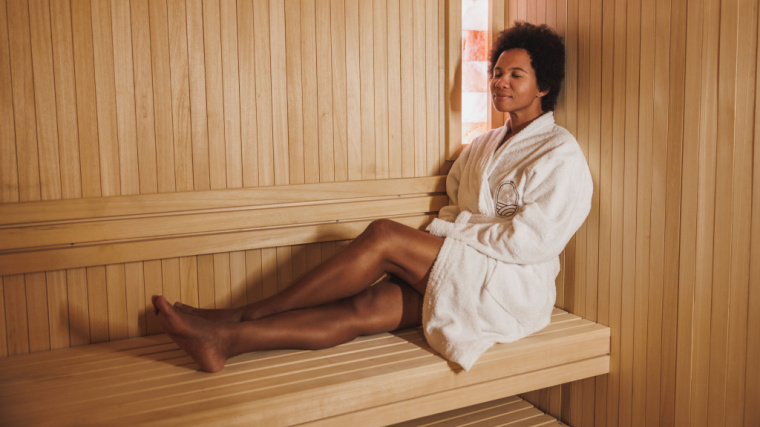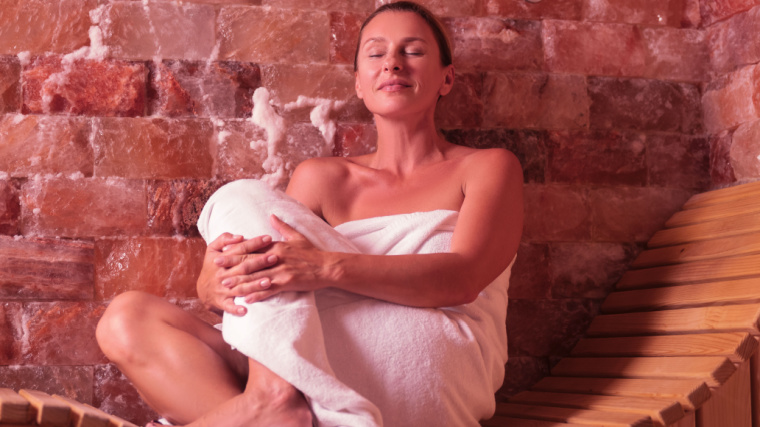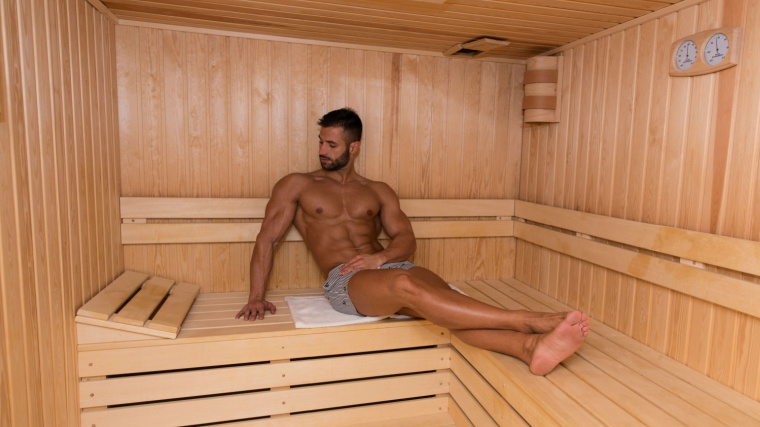The sauna in your gym locker room is much more than just a quiet place to chill out. It’s not just about the silence (though that will undoubtedly be attractive to many athletes juggling a loud gym with a busy home life). There are plenty of reasons that so many athletes hit the sauna after a sweaty workout.

The multifaceted benefits of regular sauna use have been recognized for centuries in locales like Finland, a country where there are over three million saunas — enough to house every single Finn at the same time. Whether you’re aiming to boost your overall quality of life or are simply laser-focused on using steam rooms for muscle recovery, here are the top benefits of a sauna after a workout you’ll want to check out.
Benefits of a Sauna After a Workout
Regular sauna use has been linked to better recovery after workouts, improved sleep, and a boost to the immune system, among many other benefits. If you’ve been sauna-shy until now, these potential benefits may just change your mind.
1. Fewer Aches and Pains
Research suggests that the sauna may be useful as a complementary therapy for people with low back pain. For example, one study found that sauna use in people with low back pain was linked to reduced pain and improved quality of life. (1)
It’s also been found that people with rheumatic diseases or frequent headaches could benefit from hopping in the sauna, too, as sauna use may help with pain relief for people experiencing these conditions. (2) People with osteoarthritis, rheumatoid arthritis, and fibromyalgia may all be able to benefit from the sauna. (2)
2. Better Cardiovascular Health
There’s some evidence that regular sauna bathing can lower your risk of diseases like cardiovascular disease, stroke, and high blood pressure. (2)
[Read More: The Best Online Workout Programs For Coaching, Cardio, Value, And More]
Your body’s physical response to a sauna bath is similar to when you go for a brisk walk. (2) Because of the way your body reacts to the dry heat of a sauna, there’s a whole host of cardiovascular benefits for regular sauna-goers, including a potential for improved blood circulation and overall heart health, as well as a potentially reduced risk of heart disease. (2)
3. May Reduce Your Risk of Dementia and Alzheimer’s
Sauna-goers may benefit from protection against dementia and Alzheimer’s disease. (3) However, this study investigated only cis, middle-aged Finnish men. (3) While this is potentially promising, much more research is needed on this subject.
4. Healthy Skin
[Read More: The Best Healthy Fast Food Options at the Most Popular U.S. Chains]
Using the sauna can help to treat skin conditions like psoriasis by encouraging the removal of the hyperkeratotic scales on the skin that are found in this condition. (4) The sauna’s heat can kill dermatophytes and other infective microorganisms — these live on your skin and can sometimes cause skin conditions if too many build up. (4)
It’s worth noting that hydration is also a critical component of skin health — and it’s essential to hydrate with plenty of water and even electrolytes to combat any potential dehydration from the high temperatures of the sauna.
5. Relaxation
It may come as no surprise that sauna use can reduce stress and encourage a sense of mental and physical well-being. (2) Saunas have been used for thousands of years, traditionally for relaxation. (2)

[Read More: How Much Water Do You Really Need to Drink a Day?]
This stress relief is both mental and physical. The heat of a sauna can help improve blood flow, widening blood vessels and encouraging your muscles to relax, which can be just what your body ordered after a grueling workout or even a stressful work meeting. (5)
6. Immune System Boost
There’s nothing like a bout of flu to throw your training schedule off course. Strength athletes will often take any advantage they can get against illnesses that can compromise their program.
Heat therapy like sauna use has been linked to supporting a more resilient immune system. (6) Even a single sauna session can strengthen your immune system, so the sauna could be your new best friend when sniffle season rolls around. (6)
7. Weight Loss
Many athletes have no interest in weight loss. But many do. Sauna use is a popular tactic for rapid weight loss in sports like judo, wrestling, and horse racing. The rapid weight loss experienced in these scenarios is about the loss of fluid from sweating in the sauna, which is about water weight rather than a sustainable, holistic fat loss. (7)
[Read More: How to Calculate Your Macronutrients for Weight Loss]
However, the sauna may be an option for people looking for longer-term weight loss because sauna bathing actually burns calories as your body tries to regulate its temperature in the heat of the sauna. (8) On average, the people studied (all cis men, in this case) burned 73 calories in their first 10 minutes of sauna use and 134 calories in their last 10-minute session. (8)
8. Mental Health Benefits
People who use the sauna regularly may benefit from an increased sense of well-being. (2) Research suggests that using the sauna can protect against some of the stresses of everyday life, and trips to the sauna may even help reduce psychotic symptoms in some mental health conditions. (2)
As with any component of your health, it’s best to discuss symptoms like this with a licensed medical professional before starting any new treatment regimen.
9. Detoxifying Effects
There’s a program devoted to the reported “detoxifying” impacts of saunas, called the Hubbard sauna regimen. It is designed to “remove toxins and restore health.” (9) This program includes sauna bathing, exercise, and vitamin supplements, and it’s used in over 20 countries by over 70 medical and drug rehabilitation practices. (9)
A buildup of toxins in your body is linked to autoimmune conditions, asthma, allergies, cancers, mood changes, and a whole host of other conditions that are best avoided. (9) Heavy sweating in a sauna may help flush some of these toxins out. (9)
10. Better Sleep
There’s some evidence that regular sauna-goers may sleep better than the average person. A study based in Finland linked sauna use to better sleep, and there’s research that suggests that using a sauna regularly may help improve the sleep of people with chronic pain. (10) (11)
Does it Matter When You Hit the Sauna?
It might seem natural to sauna pre-workout — getting warmer is key, right? Well, yes, but the sauna isn’t the best place to warm up. You need a dynamic warm-up to be fully prepped for your workout, rather than a sauna session where you run the risk of overheating before you’ve even got started. (12)

[Read More: The 12 Best Supplements for Muscle Growth]
On the flip side, your body can experience something called oxidative stress after a workout. This is when your body’s antioxidants and free radicals aren’t properly balanced. The sauna can help you re-balance faster by reducing oxidative stress, which is one of the reasons a post-workout sauna is so great for recovery. (13) In short: after is best.
How to Use the Sauna
There are some basic ground rules when it comes to hopping into the sauna. It’s not a great idea to spend the whole day in there or have the temperature very high (or too low). And it’s got to be clean.
How Long Should You Stay in the Sauna?
Most research into sauna use recommends staying in for between five and 20 minutes at a time. (2) For newbies, it’s always best to start small to avoid the risk of overheating. Over time, you can build up to those longer 20-minute sessions.
[Read More: The 11 Best Fat Burner Pills That Work]
Whether you’re having a very quick session or a longer one, you’re bound to sweat a lot. Make sure you’ve hydrated before your session and that you continue to hydrate well after you’re done.
How Hot Should Your Sauna Be?
It depends on the whereabouts of the sauna you’re taking the temperature. The best sauna temp, research suggests, is 80 degrees Celcius to 100 degrees Celcius (176 degrees Fahrenheit to 212 degrees Fahrenheit) at the level of your head. (2)
The temperature is lower at floor level, which keeps the sauna ventilated and makes sure that it’s comfortable enough for bathers to stay in. (2)
Keeping it Clean
A quick shower pre-sauna helps to rinse any dirt off your skin. It’s always a good idea to place a clean towel underneath you in the sauna, whether you’re sitting or lying down. This reduces your risk of getting burned if the sauna temperature is too high, or picking up any infections from non-toweled bathers who’ve come before you.

[Read More: The 12 Best Fat Burners for Women]
Ditch the socks and shoes — non-slip sandals or going barefoot is best to avoid overly sweaty feet. After your sauna, another shower will wash away any sweat or toxins that have gathered on your skin. If you’ve got an active cold, flu, or other infection, opt to stay away from public saunas altogether for the sake of other bathers.
Turn Up the Heat
As a strength athlete, you likely place a high premium on the way your body functions and how effectively you recover from stress. Everything from your quality of sleep to the level of mental and physical aches and pains you deal with daily impacts how well you perform on the lifting platform.
Enter the sauna: with its relaxation benefits for your body and mind alike, the benefits of a sauna after a workout may well help you become a more resilient athlete. And the more resilient you are, the heavier your lifts are likely to become.
FAQs
It’s okay that you’ve still got questions. We’ve still got answers.
Between five and 20 minutes, but start small if you’re a beginner. For brand-new sauna bathers, try a five or 10-minute session. Listen to your body to determine how long you should stay and get out if you start to feel too hot. As you get accustomed to regular sauna baths, you can work up to the 20-minute sessions for the most benefits.
Post-workout is best. Sauna bathing can boost muscle recovery after your workout and help your muscles relax, so you leave the gym feeling your best. Pre-workout saunas aren’t a great idea, as you risk getting too hot before your workout starts.
Sitting in the sauna burns calories as your body tries to keep its temperature stable. You burn the most calories at the end of your sauna session, because the hotter you get, the harder your body has to work to keep you at the right temperature.
To name just a few: potential pain relief, lower blood pressure, reduced risk of certain health conditions, healthy skin, relaxation, weight loss, improved sleep, detoxification, mental health benefits, and a boost for your immune system.
For best (and safest) results, keep the sauna between 176 degrees Fahrenheit to 212 degrees Fahrenheit at the level of your head. It’ll be cooler at floor level, which is good for ventilation and comfort.
References
- Cho, E.-H., Kim, N.-H., Kim, H.-C., Yang, Y.-H., Kim, J., & Hwang, B. (2019). Dry sauna therapy is beneficial for patients with low back pain. Anesthesia and Pain Medicine, 14(4), 474–479.
- Laukkanen, J. A., Laukkanen, T., & Kunutsor, S. K. (2018). Cardiovascular and Other Health Benefits of Sauna Bathing: A Review of the Evidence. Mayo Clinic Proceedings, 93(8), 1111–1121.
- Laukkanen, T., Kunutsor, S., Kauhanen, J., & Laukkanen, J. A. (2017). Sauna bathing is inversely associated with dementia and Alzheimer’s disease in middle-aged Finnish men. Age and Ageing, 46(2), 245–249.
- Hannuksela, M., & Väänänen, A. (1988). The sauna, skin and skin diseases. Annals of Clinical Research, 20(4), 276–278.
- Ahokas, E. K., Ihalainen, J., Hanstock, H. G., Savolainen, E., & Kyröläinen, H. (2023). A post-exercise infrared sauna session improves recovery of neuromuscular performance and muscle soreness after resistance exercise training. Biology of Sport.
- Pilch, W., Pokora, I., Szyguła, Z., Pałka, T., Pilch, P., Cisoń, T., Malik, L., & Wiecha, S. (2013). Effect of a Single Finnish Sauna Session on White Blood Cell Profile and Cortisol Levels in Athletes and Non-Athletes. Journal of Human Kinetics, 39(1), 127–135.
- Barley, O. R., Chapman, D. W., & Abbiss, C. R. (2018). Weight Loss Strategies in Combat Sports and Concerning Habits in Mixed Martial Arts. International Journal of Sports Physiology and Performance, 13(7), 933–939.
- Podstawski, R., Borysławski, K., Clark, C. C. T., Choszcz, D., Finn, K. J., & Gronek, P. (2019). Correlations between Repeated Use of Dry Sauna for 4 x 10 Minutes, Physiological Parameters, Anthropometric Features, and Body Composition in Young Sedentary and Overweight Men: Health Implications. BioMed Research International, 2019, 1–13.
- Cecchini, M., & LoPresti, V. (2007). Drug residues store in the body following cessation of use: impacts on neuroendocrine balance and behavior–use of the Hubbard sauna regimen to remove toxins and restore health. Medical Hypotheses, 68(4), 868–879.
- Urponen, H., Vuori, I., Hasan, J., & Partinen, M. (1988). Self-evaluations of factors promoting and disturbing sleep: An epidemiological survey in Finland. Social Science & Medicine, 26(4), 443–450.
- Masuda, A., Koga, Y., Hattanmaru, M., Minagoe, S., & Tei, C. (2005). The Effects of Repeated Thermal Therapy for Patients with Chronic Pain. Psychotherapy and Psychosomatics, 74(5), 288–294.
- Iversen, V. M., Norum, M., Schoenfeld, B. J., & Fimland, M. S. (2021). No Time to Lift? Designing Time-Efficient Training Programs for Strength and Hypertrophy: A Narrative Review. Sports Medicine, 51(10).
- Sutkowy, P., Woźniak, A., Boraczyński, T., Mila-Kierzenkowska, C., & Boraczyński, M. (2013). The effect of a single Finnish sauna bath after aerobic exercise on the oxidative status in healthy men. Scandinavian Journal of Clinical and Laboratory Investigation, 74(2), 89–94.
Featured Image: MilanMarkovic78 / Shutterstock
The post 10 Benefits of a Sauna After a Workout That Will Revolutionize Your Recovery Strategy appeared first on BarBend.
